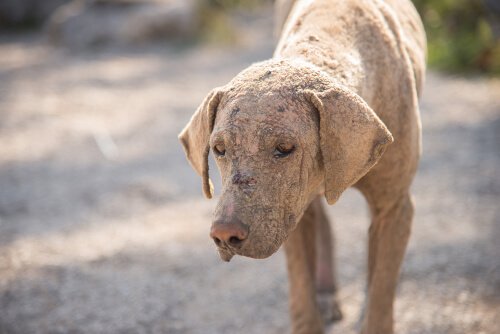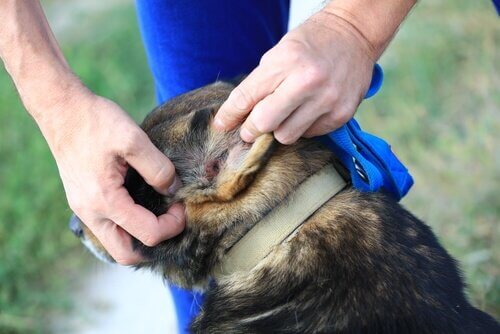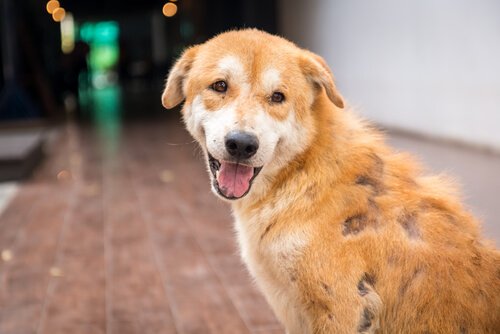How to Identify and Treat Acariasis in Dogs

Acariasis in dogs, also known as scabies, is a cutaneous disease that worries pet lovers considerably. Even though it’s treatable, it’s also quite important to detect it early, not too long after it appears.
By catching it early, the treatment required will make it simpler for the animal to regain its well-being. Furthermore, you’ll prevent contamination from spreading to other animals in the area.
If you detect the following symptoms then visit your vet for them to be able to prescribe a specific treatment.
Symptoms of acariasis in dogs
Intense itching
The dog begins to bite specific areas of their body, or rub himself against objects in order to try to relieve the itching. Moreover, they do so continuously and urgently and some even lose their ability to concentrate.
They stop eating and lose interest in daily activities that usually give them pleasure.
Irritation, redness, and inflammation
The dog’s skin is inflamed by the presence of mites, making them prone to other infections. In addition, the constant burning itch upsets the dog. It’s usually followed by the loss of hair in some areas.
Nasal bleeding and sneezing
This is a symptom of rare mange but be vigilant as it attacks a dog’s snout directly and it’s acquired through the olfactory system. It’s not the most serious condition, but it does require treatment in order to get rid of it.
Presence of mites in the ears
Small white spots that move around can be seen in the dog’s ears. In reality, these are mites that accumulate in that area, causing irritation and overall discomfort. The dog becomes restless and is uncomfortable and unfocused.

Inflammation in the legs
It’s a good habit to periodically check your dog’s legs to try to detect any form of inflammation or irritation. The mites that freeload around this area are difficult to evict. The closer they are to the claws, the more serious the condition will be and the more likely the appearance of second-degree infections.
Anorexia
A sudden decrease in weight or appetite may indicate acariasis in dogs. It’s fundamental to get checked by a veterinarian in order to detect which type it is. Furthermore, they’ll prescribe the appropriate medication to stop the deterioration of the dermis.
You should know that, if it’s left untreated, then anorexia will affect and cause imbalances in other organs too.
In regard to the symptoms
Most of these symptoms are the main indicators of a possible presence of scabies. It’s not necessary for all of them to be present at the same time; each symptom indicates a specific type of acariasis.
Medications
Before starting any treatment you’ll need to get an exact diagnosis. In addition, veterinarians should analyze other factors such as breed, age, and weight. After that, they’ll most likely prescribe an acaricide with selamectin, moxidectin, ivermectin, and milbemycin oxime.
The treatment is usually accompanied by analgesics and anti-inflammatories, and so it’s essential to complete the treatment in the period of time specified. It often happens that the mange seems to have disappeared, but unfortunately, in many cases, it’ll most likely reappear after some time.
Natural remedies for acariasis in dogs
Certain ingredients or homemade remedies help to facilitate the healing process. However, they’re not a cure on their own and they’re only good for relieving the symptoms of acariasis in dogs, as a complement to the prescribed medication.

Vitamin supplements
Providing vitamins strengthen a dog’s immune system. Their defenses increase and they can resist the attack of the invading mites. The animal will then regain its energy and will want to eat again.
Special baths
Warm water and a bar of neutral soap or an acaricide decrease itching. It’s important to ensure that the animal doesn’t lick the soap while it’s on the lesions. Rinse it gently, without rubbing –it should air dry on its own.
Natural antiseptics
Place a mixture of ground garlic and olive oil, which are both natural antiseptics. Then, leave it on the skin throughout the night and remove it in the morning with a damp cloth.
The Neem herb is also good as it promotes skin regeneration and has antibacterial properties.
Olive, lavender, and almond oils
To apply this remedy, place these oils on the affected areas. Subsequently, they’ll weaken the mites that cause acariasis in dogs. It’s a good topical application to combat the parasites. The oils also help maintain the skin well hydrated.
Chamomile
For keeping wounds clean, chamomile is a basic remedy that prevents all types of infections. Not only are the infusions refreshing but they also keep a high level of hygiene. This plant’s properties are quite soothing for broken skin.
All cited sources were thoroughly reviewed by our team to ensure their quality, reliability, currency, and validity. The bibliography of this article was considered reliable and of academic or scientific accuracy.
- Fondati, A., De Lucia, M., Furiani, N., Monaco, M., Ordeix, L., & Scarampella, F. (2010). Prevalence of Demodex canis-positive healthy dogs at trichoscopic examination. Veterinary Dermatology. https://doi.org/10.1111/j.1365-3164.2009.00769.x
- Sarna demodécica, HOSPITAL VETERINARIO BENIPEIXCAR. Recogido a 27 de enero de 2022 en https://www.hospitalveterinariobenipeixcar.es/sarna-demodecica/#:~:text=Se%20trata%20de%20una%20enfermedad,sanos%20sin%20provocar%20ninguna%20alteraci%C3%B3n.